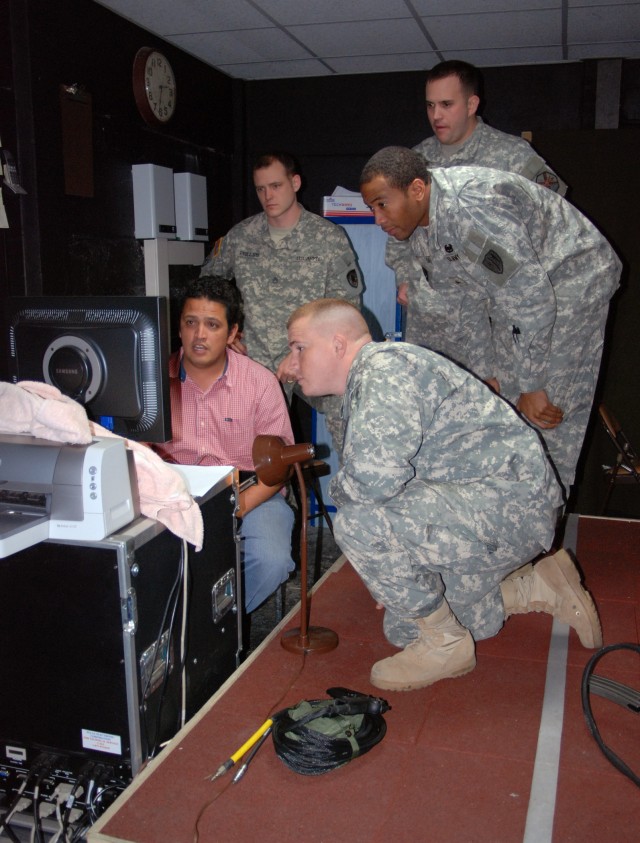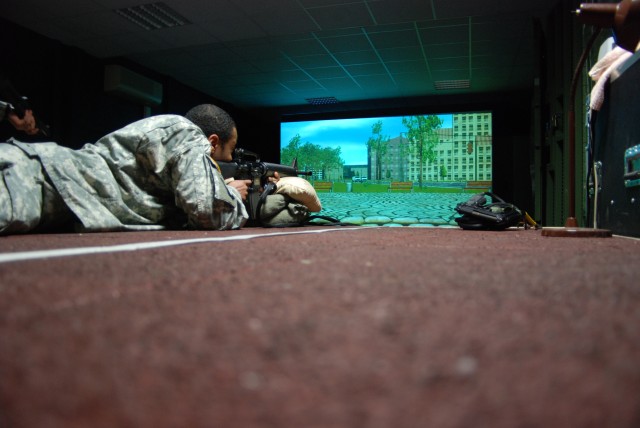CHIAfaEURoVRES AIR BASE, Belgium - U.S. Army Garrison Benelux may not have the armor power of Fort Hood, Texas, or the infantry forces of Fort Bragg, N.C., but when it comes to technology, its installations are equipped with some of the Army's best automation equipment: The Engagement Skills Trainer 2000 and Northern Europe's only Digital Training Facility.
The Army deployed the EST 2000, a digital marksmanship training tool, to installations around the world at the turn of the century. ChiAfA..vres Air Base, in Belgium, and USAG Schinnen, in the Netherlands, were among the recipients of the platform. Both garrisons provide training support to NATO servicemembers stationed in their regions.
The EST 2000 allows troops to practice firing the small arms in their unit's inventory, using scenarios appropriate to the unit's mission.
Luiz Velez, a training support specialist at the ChiAfA..vres EST, recently taught Soldiers from the USAG Benelux Military Police, 650th Military Intelligence Group and the U.S. Army NATO SHAPE Battalion how to operate the system.
"The training allows Soldiers more flexibility, he said, "so now they can train anytime they want." They don't have to draw ammo or have a safety officer present, he added.
The diversity of the EST 2000 allowed the noncommissioned officers to adjust the downrange scenarios to a situation appropriate for their line of work.
"I've used this [weapon] in a deployed environment, and this is a great way to train," said Staff Sgt. John Phillips, a training NCO with 650th MI Group.
Phillips had only been at SHAPE for two months when he received the operator training, but he could already see how it was going to benefit his unit. The 650th MI Group is made up of Soldiers and civilians who deploy downrange, and while the Soldiers attend basic training and learn the ins-and-outs of certain weapons, civilians don't have those same requirements.
Phillips said the EST 2000 is a great way to keep civilians prepared for their missions. "It ensures you don't lose familiarity," he said.
In addition to training scenarios like encountering an enemy or friendly helicopter or facing a desert ambush, the computer-based platform allows Velez and the new operators to control other elements.
"You can design your own type of scenarios," he said. "You can change the weather and the daylight experience."
Another benefit of the EST 2000 is the immediate feedback. Following a one- to two-minute exercise, the monitor displays shots fired, hits, misses, percentages and more, allowing the training NCOIC to adjust accordingly for individual Soldier's needs.
"It's good for Soldiers in the unit who haven't fired in a while," said Sgt. Joe Daley, USAG Benelux MP, adding that it helps them perfect their skills and prepare for weapons qualification.
In addition to maintaining marksmanship skills, as Soldiers' careers progress and as Army systems evolve to support ever-changing missions, the Army requires additional schooling like the Basic Noncommissioned Officers Course and Medical Protection System.
Living on the other side of the planet can make traveling to military schools in the States challenging and expensive for those working with NATO, which is one of the reasons the Army launched the Distributed Learning System.
"Distributed Learning leverages technology to bring training to Soldiers anytime, anywhere," said Brett Anderson, the Digital Training Facility manager at ChiAfA..vres Air Base.
"Army-wide there are 200 DTFs around the world. All of the DTFs can link with one another to facilitate training that takes place at a single location," he added.
The recently-upgraded DTF at ChiAfA..vres Air Base, operated by the 7th Army Joint Multinational Training Command, is the only one in Northern Europe, and therefore services every unit within the USAG Benelux's seven-nation footprint.
At the DTF, Servicemembers, civilians, military and DoD Family members and some foreign military personnel can take part in Web-based training, Video Teletraining and more.
"Some of the courses delivered via VTT are BNCOC Phase I, Battle Staff Non-commissioned Officer Course, and MEDPROS," said Anderson.
"The DTF is also set-up like any traditional classroom, and resident training can be conducted using technology such as PowerPoint presentations, CD-ROM, DVD in tandem with multi-media projectors available at the facility," he added.
Aside from professional development, the DTF is available for Army e-Learning courses. Army e-Learning offers thousands of free course hours in a variety of languages like Dutch and French, using Rosetta Stone. It also provides training in business skills, system administration, office systems and more.
"Soldiers may access these resources using any computer," said Anderson. "The DTF, however, provides a clean, quiet place free of distractions where soldiers can complete their online training requirements."
Anderson encouraged units and individuals in the region to use the free resource. "In doing so, money is saved, readiness is increased through training standardization and morale is improved as families no longer have to endure long separations when possible," he said.




Social Sharing